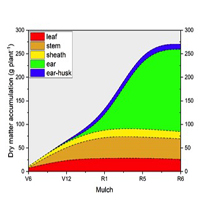Wheat straw mulch improves summer maize productivity and soil properties

Accepted: 17 September 2020
HTML: 182
All claims expressed in this article are solely those of the authors and do not necessarily represent those of their affiliated organizations, or those of the publisher, the editors and the reviewers. Any product that may be evaluated in this article or claim that may be made by its manufacturer is not guaranteed or endorsed by the publisher.
Highlights
- Wheat straw mulch improved maize grain yield by approx. 18% mainly by increased kernel numbers per ear.
- Maize growth attributes and SPAD values were improved under mulch treatment compared to no-mulch.
- Straw mulching helped in maintaining comparatively higher soil moisture content (~2%) and reduced the soil temperature (~1.72°C) during the crop growth period.
Crop residue mulch in agricultural systems preserves soil health and improves crop productivity through its moderating influence on soil temperature regime and enhanced moisture retention. Therefore, a field experiment was conducted to determine the changes in soil properties and grain yield of irrigated summer maize in response to wheat straw mulching in the Northern maize region in China. The treatments investigated were: i) application of wheat straw mulch (5000 kg ha–1); and ii) no-mulch application (control). Maize growth and yield attributes were determined during various growth stages, and soil hydro-thermal properties were recorded for two depths (0-15 and 15-30 cm). Straw mulch increased the yield by 18% and also increased total dry biomass yield by 20%, compared to no-mulch. Yield increment was attributed to the increased number of ears per area and kernels number per ear. The effect on thousand kernels weight was found non-significant. Vigorous maize growth was observed under straw mulch treatment, having greater leaf area index, unit leaf rate, leaf area duration, and crop growth rate. Similarly, the dry matter partitioning for maize kernels was greater in mulch treatment. At the late reproductive stages (R3 and R5), SPAD values for ear and below-ear leaves were higher under mulch treatment. Straw mulch decreased the daytime soil temperature by 1.9 and 1.5°C on average for 0-15 and 15-30 cm soil layers, respectively. Whereas, the soil moisture content increased about 2.5% (0-15 cm) and 3% (15- 30 cm) under the mulch treatment. In crux, leftover crop residue application as mulch in irrigated maize could be a sustainable agronomic option to increase the crop productivity.
How to Cite
PAGEPress has chosen to apply the Creative Commons Attribution NonCommercial 4.0 International License (CC BY-NC 4.0) to all manuscripts to be published.

 https://doi.org/10.4081/ija.2020.1623
https://doi.org/10.4081/ija.2020.1623



